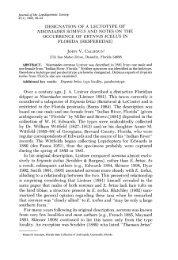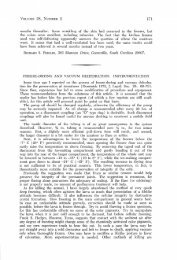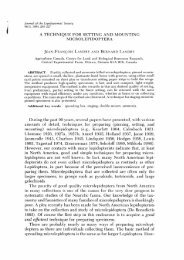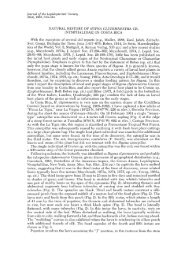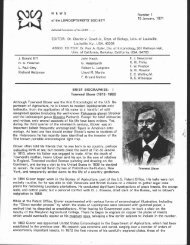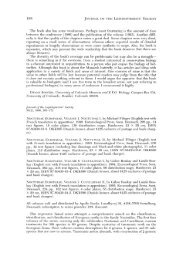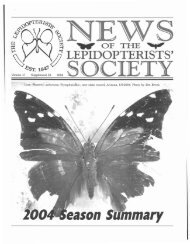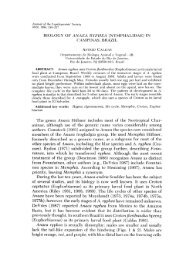HOW TO MAKE REGIONAL LISTS OF BUTTERFLIES - Yale University
HOW TO MAKE REGIONAL LISTS OF BUTTERFLIES - Yale University
HOW TO MAKE REGIONAL LISTS OF BUTTERFLIES - Yale University
Create successful ePaper yourself
Turn your PDF publications into a flip-book with our unique Google optimized e-Paper software.
Journal of the Lepidopterists' Society33(4), 1979, 216-231<strong>HOW</strong> <strong>TO</strong> <strong>MAKE</strong> <strong>REGIONAL</strong> <strong>LISTS</strong> <strong>OF</strong> <strong>BUTTERFLIES</strong>:SOME THOUGHTSlHARRY K. CLENCH 2Carnegie Museum of Natural History, Pittsburgh, Pennsylvania 15213ABSTRACT. Procedures are described for making two types of regional lists ofbutterflies: the state or provincial list, and the "local study" (an intensive, long-terminvestigation of a small area). The need for such lists, problems in making them, andsome of the expectable results, are examined. A logarithmic scale for describing populationsizes is given, as is a procedure for estimating total number of species in a localarea.STATE AND PROVINCIAL <strong>LISTS</strong>State or provincial lists are important sources of regional informationabout a variety of aspects of butterflies, the particular aspectsbeing up to the writer. At the least such lists should include distributionrecords, and they may also provide data on number and timingof broods, habitat choice, rarity, phenotypic and geographic variation,and so on.As I pointed out many years ago (Clench, 1949), these lists areinvaluable to taxonomists, zoogeographers, ecologists, and to researchersconcerned with many other types of problems as well. Theyare also useful to both resident and visiting collectors, showing whenand where to look for particular species. An often little-appreciatedvalue of such lists is in their "negative information" content: an omissioncan inform the collector of needed data-a still unknown foodplant,an imguessed fall brood, as well as the more striking unrecordedspecies-and thereby encourage him to publish any such newlyacquired information.MethodsIt is useful, in gathering and storing data, to keep two loose-leafnotebooks: a species book and a county book.The species book is the main list and comprises a separate sheetfor each species, more eventually if needed. On each species sheetenter the full data for all records of that species that you acquire.Enter the records as received, in no particular order. I always put theI At the Lepidopterists' Society meeting in LouisviHe in 1978 I gave a paper on this subject, and several of thoseattending suggested that the information be made more permanently available. I here comply with that suggestion,amplifying and extending the original paper in a few places.This paper considers two kinds of regional1ists: state lists or their equivalent; and what I call "local studies"long-term investigations of small areas. Each requires a different approach, and each will be treated separately.2 Editor's note: This paper is puhlished posthumously following Mr. Clench's sudden and untimely death in April1979. A future issue of the Journal will be published as a memorial to commemorate his many contributions to thestudy of Lepidoptera, and to the Lepidopterists' Society.
218 JOURNAL <strong>OF</strong> THE LEPIDOPTERISTS' SOCIETYcan be a problem. An outstandingly useful source is Field, dos Passos,and Masters, 1974. This bibliography, as its authors note, is not necessarilycomplete, so you should do some extra searching. In additionto earlier regional lists, monographs of various genera and other taxaoften contain many locality records.Collections. (a) Large museums have at least some material fromalmost every state and province. (b) Small museums, state collegesand universities, state museums, nature centers, etc., often have localand/or student collections. These may prove to be a gold mine of earlyor otherwise unusual records, but watch for poor data. (c) Privatecollections and collectors are probably your richest source of informationoutside your own efforts. The local collector has often beenactive for many years and may have exceptionally complete data onthe species in his area: identities, broods, timing, larval foodplants,and so on, information of the utmost value and not duplicated elsewhere.I have found such collectors to be extremely helpful and invariablymore than willing to share their hard-won knowledge.Problems. (a) Misidentifications. With experience you soon learnwhich are the problem children: among them Erynnis, Hesperia, andother hesperiids; Euphydryas, Speyeria, some lycaenids, Calephelis.You may want to borrow specimens to confirm an identification, orsend your own to a specialist. In any event, do not hesitate to queryor even omit a dubious record, or you can assign it to the "hypotheticallist" (see below). "Thorybes sp." is much preferable to "Thorybesbathyllus" which is actually Thorybes pylades. The famous early Cubannaturalist, Felipe Poey, has a wise saying: Mas vale ignoranciaque error (Ignorance is worth more than error).(b) Stick to what you know. Do not assume any species-even Pierisrapae-to be anywhere. Even common species may have gaps in theirranges, and this would be important and interesting information. Ifyou find what seems to be a gap in the range of a species that"shouldn't" have such a gap, go check it out. It may be real.Procedure in FieldworkIdeally your fieldwork should be conducted in two concurrent phases:(1) an intensive, prolonged study of a small, easily accessible area(see under "local studies" below); and (2) field trips to farther placeswithin your state or province.The principal goal of the latter is to add as many distributional dataas possible, expressed (or summarized) in terms of county records.Your aim is to acquire as much information as you can in the time atyour disposal. Initial efforts should be directed at simply adding asmany county records as possible. Pick the season when the most
VOLUME 33, NUMBER 4 219species are flying (often June and July, but not always or everywhere),and visit as many counties as time and funds permit. A fairly respectablelist of species and county records eventually will be amassed,and your attention may then gradually shift to intensified efforts atmore specific goals: a county still poorly represented; a species thatought to be present but of which you have few records or none. Thesearch for such a species is more efficient if you first familiarize yourselfwith available information about its habits, larval food, flight periods,and so on. Remember, some species fly only in particular seasons,especially the spring, so seasonal collecting should be added toyour field exploration program.Although you can think of the task as one of accumulating countyrecords, always remember that that is not the real goal but merely asimplified accounting proccdurc, useful for record-keeping and statisticaltreatment. With that in mind, it may help to discuss somepossible patterns you may observe.Every county has some upper limit to the number of species in it.In a reasonably diversified state some counties will have relativelymany species, others fewer. If the counties are more or less uniformin size and range of habitats, then the number of species in themshould be distributed in a Gaussian or normal curve, as in Fig. lB.Before you have begun to accumulate records, all counties in thestate have precisely zero species known from them: they would allbe ranged in a single bar at the extreme left of such a curve. As youacquire records the counties begin to move up the graph to the right.A single visit to a hitherto uncollected county may result in a dozenor so species records, shifting that county up one class interval to theright. With more visits the number will gradually increase. In Pennsylvania,a state I know well, a reasonably well-worked county-severalvisits in different seasons-will have records of some 20-60species. To increase the number beyond that point takes far moreeffort, generally possible only by residence or intensive local collecting.After some years of work, both on your part and on the part of earlierworkers as well as collaborators in various parts of the state, the distributionof counties according to number of species will look somethinglike Fig. lA, which shows the current state of knowledge ofPennsylvania butterflies. Note that the curve at this time is essentiallythree-humped: (a) a group of 25 counties (37% of the 67 counties inthe state) with fewer than 20 records each, representing those eithercollected in briefly or not at all; (b) a group of 28 counties (42%) withbetween 20 and 60 records each, representing those visited a numberof times and in different seasons; and (c) a group of 12 counties (18%)
220JOURNAL <strong>OF</strong> THE LEPIDOPTERISTS' SOCIETY3030BUII1Ji=z::Ie()LleozUII1Ji=z::I8 10Lleezo 20 40 60 80 100RECORDS PER COUNTYo 20 40 60 80 100RECORDS PER COUNTYFIG. 1. A. Present state of knowledge of Pennsylvania butterflies. Note the threehumps in the curve: a group of counties with fewer than 20 records each; a group withbetween 20 and 60 records each; and a group with 60 or more records each. B. If allPennsylvania counties we re completely known, the curve would probably look essentiallylike this.with 60 or more recorded species each. These last are counties witha long history of collecting (Allegheny and Philadelphia counties); orwith collectors long resident (Lancaster Co. [George Ehle], or TiogaCo. [George Patterson)); or in which especially intensive, long-termcollecting has been done (Westmoreland Co., where Carnegie Museumhas a field research station). The distribution of collecting intensityin Pennsylvania as measured by the number of species knownfrom each county, is shown in Fig. 2.If the curve in Fig. 1B is summed (midpoint of each class intervaltimes number of counties in the class interval, and these totalled), wehave a theoretical maximum possible number of county records forPennsylvania of about 5,715. The total number now actually knownis 2,215, or 39% of those possible. Although this seems like a smallnumber, it is the result of many thousands of hours spent in the fieldby collectors over more than a century. It shows dramatically howdifficult it is to get truly thorough knowledge about even one state.I should add, however, that because several areas have been intensivelystudied, about 145 species are now known from Pennsylvania,
VOLUME 33, NUMBER 4 221FIG. 2. Distribution of collecting intensity by counties in Pennsylvania. Countieswith no shading have 20 or fewer records each; those with light shading have between20-60 records each; and those with dark shading 60 records or more each.and this total is not likely to be much increased in the future: perhapsby no more than about 10.Special MattersWherever you may be, you can help other lepidopterists. Perhapsa taxonomist revising a group needs material or information from yourstate; or a geneticist may want to find a colony of a particular speciesin your area, or someone working on Monarch migration might needlocal dates of immigration or emigration. For all such people the specialknowledge you have acquired could be of great value. And donot forget reciprocity: his (or her) special knowledge may be of particularvalue to you someday as well.Be aware of research that already has been done and that is relevantto your area, and make an effort to extend the results. One frequentproblem is the nature of the boundary between two wide-rangingsubspecies. If that boundary passes through your state, and the materialyou have acquired is adequate, you are uniquely situated to addprecision to what is known.You may discover new problems. No general rule applies here.Keep an inquiring mind, and be alert for things that "don't fit." Perhapsyou know of a local population with a different flight period than
222 JOURNAL <strong>OF</strong> THE LEPIDOPTERISTS' SOCIETYthe species has elsewhere, or with a higher-than-usual frequency ofsome dimorphic form. Or you might have noticed a persistent andanomalous absence of some species from areas where it should befound. A new species turning up in your area might represent a rangeexpansion, something we know little about.The GoalThe objective in preparing a state list is the accurate record of conditionsin a particular place-your state-at a particular time or times,and in as much detail as you are capable of.Accuracy is vital. Rumored occurrences and sight records are admissibleonly if they are clearly so reported. Misidentifications, ideally,should never occur. Some few are bound to, but make everyeffort to eliminate them completely: submit doubtful specimens to aspecialist; record any uncertain identifications as such. Be meticulouswith specimen data, and ultracareful in recording the information.Data on brood numbers and timing, on larval foodplants, and otherattributes, should be clearly identified as to geographic source. If youhave no local data it is proper and even wise to copy from the literature(because it will provide clues for future users of your list), butyou should clearly indicate that the information was not locally obtained.Be aware of old records not recently duplicated; of species commonnow but not mentioned by "the old boys." Such things may seemunimportant but could fit in with data from other areas to demonstratea pattern. A recent instance of this began with the account of Nathalisiole by Kimball (1965). He remarked on the absence of early recordsfrom the state and concluded that it might have established itself inFlorida relatively recently. I became interested, checked two largemuseum collections and other early literature and concluded that ioleindeed previously was absent from Florida, that it reached the statein 1913 or shortly before, and spread north from its probable originallandfall in the Keys (Clench, 1976).MiscellaneousA state list may invite a zoogeographic or ecological analysis, orother derivative study. If your interests lie in these directions, somuch the better: a list can only be improved by such work. But these"extras" are not necessary. What is necessary is a careful, accuratecompilation of reliable information. If you provide this, then your listwill be a valued and respected contribution to our science, useful andused for a long time to come.
VOLUME 33, NUMBER 4 223The "hypothetical list." Ornithologists are familiar with this term;lepidopterists are not. In your published list itself, include onlyspecies with established reliable records. Save the rest for the "hypotheticallist" at the end. It is the perfect place for the doubtfulspecies, the "possibles," those previously reported in error. Anythingdubious can go in. This device allows you to avoid the difficult decisionof what to include in, and what to exclude from, the main list.Amplify and discuss the entries as you will. The "hypothetical list"is a wonderful place for the reader to browse when your paper iseventually published.The work of assembling a state list is never done. Information alwaysremains to be learned, and always will. The trick is knowingwhen you have reached the point when you can properly say, "Thisis now worth publishing." Eventually the time comes when you havea reasonable picture of the butterflies of your state, embodying a satisfyingquantity of new data. If at this point the influx of new infor~mation slows, then the time clearly has come to put it all together andget it into print.As the foregoing should have intimated, preparing a state list is nota simple task. It requires experience, knowledge, and judgement, aswell as diligence. It is not really a job for a beginner. If you are abeginner, however, and you really want to undertake such a task, thenyou should seek as much advice and help as you can from those withmore experience. If you do that, then there is no reason not to producean excellent and valuable piece of work.LOCAL STUDIESA local study, as I use the term here, is an intensive, long-terminvestigation of a small area: perhaps one or two thousand acres, aboutas much as can be covered reasonably well on foot in a single day.Studies of this kind have been undertaken so seldom that whereveryou choose to do so you will be rewarded with significant data, wellworth publishing. Because it requires no extensive collections and nolarge reference library this kind of study is particularly suited to theserious lepidopterist in a rural area. Bear in mind that much of theinformation you acquire, even though it seems of little interest initself, will gain greatly in value when added to similar informationfrom elsewhere. Among the most important eventual results of suchwork will be establishing geographic patterns of variation in broodnumbers and timing, larval foodplant choice, abundance levels, andother things about which we are still totally, or almost totally, ignorant.
224 JOURNAL <strong>OF</strong> THE LEPIDOPTERISTS' SOCIETYDefine or enunciate what you want to do at the outset, and give itcareful thought. One important aspect of a local study is time variation,for which you need data extending over as long a time as possible.The earlier you start keeping records, the longer your time-spanof useful information.Do not make your goals too many or too complicated or you willdefeat your own purposes. Know about how much time you will havefor the work and plan accordingly. After your first month or two, reviewyour program and your goals. Perhaps you have bitten off morethan you can chew; or perhaps you could easily do more than youfirst thought.The place: what to look for. Frequent visits are important. Thenearer your chosen spot is to your home, the more often you can visitit.The study area you choose should be reasonably representative ofyour region; with enough habitat diversity this should be so. In apinch, however, almost any area will do: even a vacant lot in town,if you cannot get to anything better. Nevertheless, in a day's surveyyou can record useful data on a large number of species, so (withinreason) the more diverse the area the better.Your study area should have-and have had-no pesticide spraying.It should be free from any abrupt, major change in land use: you donot want the place bulldozed for a shopping center a year after youbegin! And it should be as free of people as possible. When you arehard at work in your area you need to concentrate, to be free to followthis or that butterfly, to observe what it does. People, even the bestintentioned, interfere with this work.If you are lucky, a weather station (government or private) may belocated in or near your study area, and you can arrange for copies ofthe data. Failing this, then look for a weather station as near as possible,and in as similar a habitat as possible, and record what you canin your own area on your own visits. This is not as satisfactory, butsome idea of the regional climate is necessary.State or local parks, perhaps even a national park, if they fit otherrequirements of your study, may include suitable sites. If permits arerequired, you must get them. In any event you should get permission.The personnel of the park may even be able to help you locate thebest place for your study, if you explain your needs and aims.Universiti~s and other institutions often have their own study areas,designed for investigations of just this kind. If so, they are ideal: theyare stable in land use, free of insecticides, often have climatic records,and frequently have background data on vegetation, land use history,maps of habitat types, and so on. They may also have a policy of
VOLUME 33, NUMBER 4 225limiting the area to their own personnel. Sometimes, however, theyare only too happy to let you use the area, if you ask first, explain youraims, and don't mistreat the area.Private lands often have ideal places for such a project. Again, askthe owner and get his permission first. In recent years the land ownerhas gotten much more hard-nosed about strangers on his land. He orhis neighbors may have been victimized by careless or maliciouscampers, wanton vandals, drunken or stupid hunters, and who knowswhat else: his attitudes can hardly be faulted. In most cases, however,if you can satisfy him that you are serious, and that you will not tramplehis crops or leave trash behind you, he will willingly let you usehis property.In using any land ordinary courtesy is necessary. Do not litter; donot walk on crop plants; do not leave gates open if they were closed,and vice versa, follow paths as much as possible. If the area is alreadyin use by other researchers, familiarize yourself with what they aredoing and be careful not to interfere with their projects. Respect fullyany ground rules that may be in force. Regardless of who owns theland, it is good public relations to keep them informed, if only in ageneral way, of your progress. If you find a rarity, or make an importantor unusual discovery, tell them. Land owners or managers liketo hear that their place is "special." And when you publish, acknowledgethem by name, and give them a reprint of your paper.MethodsI assume that you have chosen an area, and that you will be makingperiodic visits, perhaps once a week or so. As in state lists, I keep twobooks of records:(1) Log book. This need not be loose-leaf, as it is strictly chronological:on each visit enter date, time you begin fieldwork, and timeyou finish. Record weather data (temperature, cloud cover, wind; andany important changes during your visit). List the species you take orobserve in the area, where you see them, how common they are, theircondition: these three matters are discussed more fully below. Recordany special observations, such as territorial behavior (time of day,territorial activity, size of territories, and so on), predator attacks (details),mating or courtship behavior (nature of activity, time, sex of theflying partner in copulating pairs, and so on), unusual numbers, ovipositionrecords, flowers serving as adult food, etc.(2) Species book. This should be loose-leaf, to allow additions. Aseparate sheet (or more) for each species, entering dates, particularplaces, and other information from your log. It will be repetitive, certainly,but this accumulation of data is the core of your whole project.
226 JOURNAL <strong>OF</strong> THE LEPIDOPTERISTS' SOCIETYYou will need to accumulate a voucher collection, either keepingit yourself, or giving it to some inititution. It should comprise reasonableseries of each species, and of each brood, and of any problemgroups or unusual specimen for which documentation or later studymay be necessary. After this, collect as little as possible: the job isprimarily one of observation and recording. With a little familiarity,most species can be identified without capture. Certain groups, suchas Polygonia, Erynnis, or some of the smaller hesperiids, may needto be captured for reliable identification. Many can then be released,but some must be kept for more careful identification later. Be alertfor the rare species that in the field looks much like some commonspecies.The following procedures can improve the accuracy and detail ofyour observations, and hence their later utility. Your study area canbe divided into a number of "microlocalities." It is important to beable to specify these, in order to localize observations on habitatchoice, colony locations, and so on. Two basic methods are used:(1) A grid system, in which the whole area is marked off by a rectangulargrid. In one type of grid the squares are identified, "B-6," forexample, referring to the square in row B, column 6. In the other typeof grid the lines are identified, so that a square may be specified bythe intersection of some standard corner, or a point identified by afractional designation such as "5.6 E, 6.1 N," meaning 0.6 unit eastof line 5 and 0.1 unit north of line 6. A grid system can be particularlyprecise, but it requires more than just drawing the lines on a map:you must have some means of identifying them on the ground, too,or they are of little use. Survey markers along trails or at grid lineintersections is one method. Generally, if the area you use does notalready have a grid system, it is too involved and expensive to set oneup.(2) Place names. Sometimes an area under study will have them, orsome of them already. If so, use them. If they do not exist, then youwill need to make them up. Do so with thought. It is tempting to usesuch terms as "Idalia Meaciow" or "Hypaurotis Scrub," but suchnames may sometimes cause confusion in your notes. The same maybe true of botanical adjectives. Other kinds of names can be morepractical, sometimes even silly ones. One of our places at Powdermillis called "Elephant Walk." I'm not sure why, but it is certainly easyto remember. "Typha-Acoris Marsh" is there, too, and poses no problem,for that combination of plants occurs at Powdermill in only oneplace. However you do it, keep a record on a map of the locations,and document them with photographs.Recording the condition of the specimens you see is extremely use-
VOLUME 33, NUMBER 4 227ful, particularly when visits to the area are at weekly or greater intervals,because they give a valuable clue to how long the species hasbeen flying. I use a series of five lower case letters: a, perfect andunblemished; b, showing slight wear; c, definitely worn; d, extremelyworn; and e, a complete rag, the wings so rubbed that identificationmay be difficult. The important thing in this scale is wingwear, and it increases with age, so record tears in the wings separately.A tear (or bird or lizard bite) can happen in a fresh specimen andmeans little in this connection. Remember, you are using the scale toestimate the relative age of the individual since eclosion, not to describean exchange item! When you see a number of individuals of aspecies on a particular day your notes might read, "all a" (suggestingquite recent emergence), or "b-d, most c" (suggesting about themidpoint of the flight period or a little later), or "most d, one a"(suggesting a second flight beginning as an earlier flight is ending),and so on.Words like "common" or "scarce" convey a poor idea of numbers;mark-recapture techniques can give accurate population figures, butthe procedure is far too time-consuming for routine use. Some yearsago I devised a compromise system, more accurate and objective thanwords, less tedious than population estimation; it is easily used, assubsequent experience with it has shown. This abundance measureis a logarithmic scale much like that of stellar magnitudes used inastronomy, after which it was patterned. The scale records numbersseen per hour, or the equivalent, as follows:Scaleo12345678Numbers125-625 individuals seen per hour25-125 /I /I /I5- 25 /I /I1- 5 /I /I /I0.2- 1 per hour, or 1 seen per 1-5 hours1 per 5-25 hours1 per 25-125 hours1 per 125-625 hours1 per 625-3,125 hoursThe scale can be extended in either direction if needed (it rarely willbe): -1 would be the next commoner scale unit, and so on. Eachabundance unit represents 1/5 the abundance of the preceding unit,and a difference of one unit is about the minimum that can be accuratelyperceived in routine observation.
228 JOURNAL <strong>OF</strong> THE LEPIDOPTERISTS' SOCIETYIn recording abundance take due note of highly localized species(count only time spent in suitable habitats) and of flight periods (countonly time spent in appropriate months).If you know your average rate of movement through an area, andthe average width of your "sweep"-the distance you can effectivelysurvey on either side of your path (which will vary with the terrainas well as your vision and knowledge of local butterflies)-then themeasure can be converted into a rough density measure of so manyper acre, or hectare, or whatever.When only a single specimen is seen, its abundance should beentered as "4 or rarer," "5 or rarer," etc., because catching one individualcannot establish a time span.The measure is crude, but about as accurate as possible in the circumstances.Remember, too, that any measure based on visual sightingwill generally underestimate true numbers.Persistence pays. The whole idea is to continue observations for along time-several to many years-in all seasons. The following kindsof data should be expected and sought:Species list. The list will never be complete-something often notrealized-but with enough time you can approach completenessabout as closely as you wish. If you record the total accumulatednumber of species you have found (5), and the total accumulated time(in hours) you have spent observing (N), then the following relation(Clench, 1968) will describe your results quite closely:N5 =5e-- .K+N5e is the theoretical total number of species in your area, and K is anadjustable constant, related to "collectability."Powdermill Nature Reserve (of Carnegie Museum of Natural History)is an area of about 2,000 acres, located 9 miles south of Ligonier,Westmoreland Co., Pennsylvania. Since its establishment in 1956 Ihave worked on its butterflies as time allowed (little in recent years,but intensively in the 1960's). A total of 820 hours has been logged,and 73 species recorded in that time: K = 59, and 5e = 78 species.In short, we have found about 94% of the species expected there,with only 5 left to go (see Fig. 3).Calculating the "best fit" values of Se and K is difficult and complicated,too much so for inclusion here. You can approximate themfairly simply, however: draw a smooth, eye-fitted curve through yourgraphed data points; pick two well spaced positions on this curve (or
VOLUME 33, NUMBER 422980Se =78 species7019611964•196319621965 19681966 1967U)60c)1958a:2 50w •.~0wU) 40'"~W.Q!3z 30'"""" "0E-
230 JOURNAL <strong>OF</strong> THE LEPIDOPTERISTS' SOCIETYsumably because of variation in weather conditions. It takes severalyears of observation to establish reliable average times.One of the reasons for a diversity of flight periods among the speciesof a community is to minimize competition for adult food-normallyflower nectar-and a thoughtful examination of your data in this lightcould produce interesting results.Population levels. Each species has an average level of abundance:some are rare, others commoner, and some are abundant. In any givenarea the frequency distribution of species according to abundance isclose to log-normal, that is, the frequency distribution approximatesa normal curve when abundance is plotted on a logarithmic scale.Since the abundance scale ("0-8") described above is logarithmic, afrequency distribution of the species based on their average abundanceaccording to that scale should approximate a normal curve. Thecurve is truncated at the rare end, but the degree of truncation diminisheswith prolonged study. Most species vary considerably intheir numbers from year to year, and again it takes a number of yearsof observation to establish reliable average values. Some species mayhave different abundance levels in different broods, and this variation,too, should be looked for.Cycles of commonness and rarity are often present, but beware ofgeneralizing too much from them. Many cycles are transient, or nottruly cycles (having varying periods).True regular cycles are uncommon. Eventually you should find insome species a "boom and bust" phenomenon. This is a season (orflight) of exceptionally high numbers, followed by a crash, duringwhich you will see only a few individuals, or even none at all. A returnto normal numbers soon follows. At Powdermill I have seen this ina few species (Euphydryas phaeton, Polygonia comma, Epargyreusclams, Hesperia leonardus) oVer about 16 years of observation. In eachof these only one eruption was seen, ordinarily about 2 abundanceunits above normal, followed by a crash of similar magnitude, with areturn to normal numbers the year after.Habitat choices. With appropriate observation and recording, theprincipal habitat and subordinate habitats of most of the speciesshould be learned in comparatively few years. Watch for species thatregularly occupy two or more different habitats, especially (a) for feeding,and (b) for courtship, reproduction, larval growth, and inactive("sleeping") adult occupancy.Territorialism. Many butterfly species are territorial. The subjecthas scarcely been touched, and much remains to be learned. Persistentobservation should reveal territorial individuals if you are alertto what the butterflies are doing. Absence of territorialism in a species
VOLUME 33, NUMBER 4 231is harder to document, for individuals of territorial species are nonterritorialpart of the time. Some species occupy territories only atcertain times of the day (such as Vanessa atalanta, in late afternoon).In most territorial species males occupy the territories, and femaleswander in search of them.Life history data such as larval foodplants and adult food sourcesshould be noted. If you rear the early stages you can learn much more.Long observation of an area will often show some transient speciesthat move into an area, live for one or a few seasons, and then die out.At Powdermill, Nastra lherminieri arrived, lasted for several years,then disappeared, and has not been seen since. Both Euptoieta claudiaand Hylephila phyleus established colonies that died out after asingle brood.The Monarch, Danaus plexippus, is a special transient since it regularlymoves into an area in the spring, raises a local brood or two,then emigrates in the fall. The fall southward migration is conspicuousand often spectacular. It is important to keep records of its size,direction, and dates of start and finish. Just as important, however, isthe time of Monarch arrival in the spring, a far less documented eventbecause it is so inconspicuous. One can only note the date of firstspring sighting.Inevitably, long-term observation will produce genuine residentrarities, such as the celebrated Erora laeta, or strays from outside thearea-single individuals of non-resident species.When you have studied an area intensively for several or manyyears you are apt to find significant, non-random changes. They maybe changes in the trend levels of certain populations, but they couldbe other things as well. As succession alters a meadow, grasslandspecies may change from common to rare, or perhaps even disappear;a species not seen before may move in and establish itself, perhapsonly temporarily, perhaps permanently.LITERATURE CITEDCLENCH, H. K. 1949. Regional lists. Lepid. News 3: 15-16.-- 1968. A new butterfly for Powdermill. Powdermill Nature Reserve (CarnegieMus.), Educational Release no. 82: 3 p. [mimeographed].-- 1976. Nathalis iole (Pieridae) in the southeastern United States and the Bahamas.J. Lepid. Soc. 30: 121-126.FIELD, W. D., C. F. DOS PASSOS & J. H. MASTERS. 1974. A bibliography of the catalogs,lists, faunal and other papers on the butterflies of America north of Mexico arrangedby state and province (Lepidoptera: Rhopalocera). Smithsonian Contrib. Zool., no.157: 104 p.KIMBALL, C. P. 1965. The Lepidoptera of Florida. Gainesville (Fla. Dept. Agr., Div.Plant Industry: Arthropods of Florida and Neighboring Land Areas, vol. 1): v +363 p., ill.




